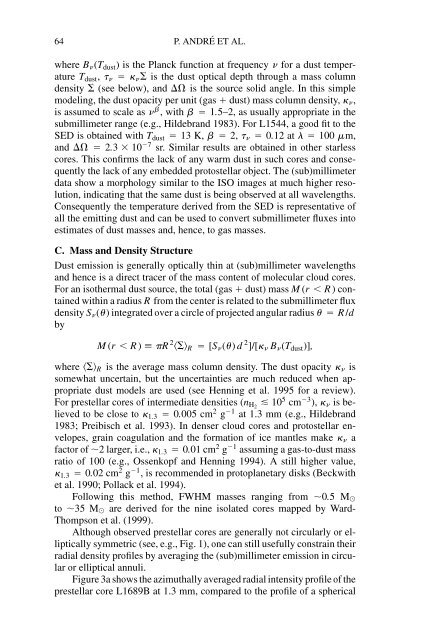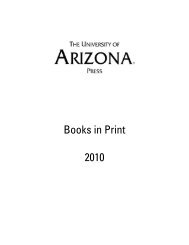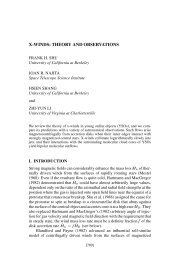from prestellar cores to protostars - The University of Arizona Press
from prestellar cores to protostars - The University of Arizona Press
from prestellar cores to protostars - The University of Arizona Press
You also want an ePaper? Increase the reach of your titles
YUMPU automatically turns print PDFs into web optimized ePapers that Google loves.
´<br />
64 P. ANDRE ET AL.<br />
where B( Tdust) is the Planck function at frequency for a dust temperature<br />
Tdust, <br />
<br />
is the dust optical depth through a mass column<br />
density (see below), and is the source solid angle. In this simple<br />
modeling, the dust opacity per unit (gas dust) mass column density, ,<br />
is assumed <strong>to</strong><br />
scale as <br />
, with 1.<br />
5–2, as usually appropriate in the<br />
submillimeter range (e.g., Hildebrand 1983). For L1544, a good fit <strong>to</strong><br />
the<br />
SED is obtained with T dust 13 K, 2, <br />
0.<br />
12 at 100 m,<br />
<br />
and 2.<br />
3 10<br />
7<br />
sr. Similar results are obtained in other starless<br />
<strong>cores</strong>. This confirms the lack <strong>of</strong> any warm dust in such <strong>cores</strong> and conse-<br />
quently the lack <strong>of</strong> any embedded pro<strong>to</strong>stellar object. <strong>The</strong> (sub)millimeter<br />
data show a morphology similar <strong>to</strong> the ISO images at much higher reso-<br />
lution, indicating that the same dust is being observed at all wavelengths.<br />
Consequently the temperature derived <strong>from</strong> the SED is representative <strong>of</strong><br />
all the emitting dust and can be used <strong>to</strong> convert submillimeter fluxes in<strong>to</strong><br />
estimates <strong>of</strong> dust masses and, hence, <strong>to</strong><br />
gas masses.<br />
C. Mass and Density Structure<br />
Dust emission is generally optically thin at (sub)millimeter wavelengths<br />
and hence is a direct tracer <strong>of</strong> the mass content <strong>of</strong> molecular cloud <strong>cores</strong>.<br />
For an isothermal dust source, the <strong>to</strong>tal (gas dust) mass M( r R) con-<br />
tained within a radius R <strong>from</strong> the center is related <strong>to</strong>the submillimeter flux<br />
density S( ) integrated over a circle <strong>of</strong> projected angular radius R/<br />
d<br />
by<br />
2 2<br />
R<br />
<br />
M( r R) R [ S ( ) d ]/[ B ( T )],<br />
where R<br />
is the average mass column density. <strong>The</strong> dust opacity <br />
is<br />
somewhat uncertain, but the uncertainties are much reduced when appropriate<br />
dust models are used (see Henning et al. 1995 for a review).<br />
n <br />
5 <br />
For <strong>prestellar</strong> <strong>cores</strong> <strong>of</strong> intermediate densities (<br />
3<br />
H 10 cm ), <br />
2<br />
is believed<br />
<strong>to</strong> be close <strong>to</strong><br />
1<br />
<br />
2 <br />
13 . 0.<br />
005 cm g at 1.3 mm (e.g., Hildebrand<br />
1983; Preibisch et al. 1993). In denser cloud <strong>cores</strong> and pro<strong>to</strong>stellar envelopes,<br />
grain coagulation and the formation <strong>of</strong> ice mantles make <br />
a<br />
<br />
<br />
2 <br />
fac<strong>to</strong>r <strong>of</strong> 2 larger, i.e.,<br />
1<br />
13 . 0.<br />
01 cm g assuming a gas-<strong>to</strong>-dust mass<br />
ratio<strong>of</strong> 100 (e.g., Ossenkopf and Henning 1994). A still higher value,<br />
<br />
2 1<br />
13 . 0.<br />
02 cm g , is recommended in pro<strong>to</strong>planetary disks (Beckwith<br />
et al. 1990; Pollack et al. 1994).<br />
Following this method, FWHM masses ranging <strong>from</strong><br />
0. 5 M<br />
<strong>to</strong> 35 M<br />
are derived for the nine isolated <strong>cores</strong> mapped by Ward-<br />
Thompson et al. (1999).<br />
Although observed <strong>prestellar</strong> <strong>cores</strong> are generally not circularly or elliptically<br />
symmetric (see, e.g., Fig. 1), one can still usefully constrain their<br />
radial density pr<strong>of</strong>iles by averaging the (sub)millimeter emission in circular<br />
or elliptical annuli.<br />
Figure 3a shows the azimuthally averaged radial intensity pr<strong>of</strong>ile <strong>of</strong> the<br />
<strong>prestellar</strong> core L1689B at 1.3 mm, compared <strong>to</strong> the pr<strong>of</strong>ile <strong>of</strong> a spherical<br />
dust






